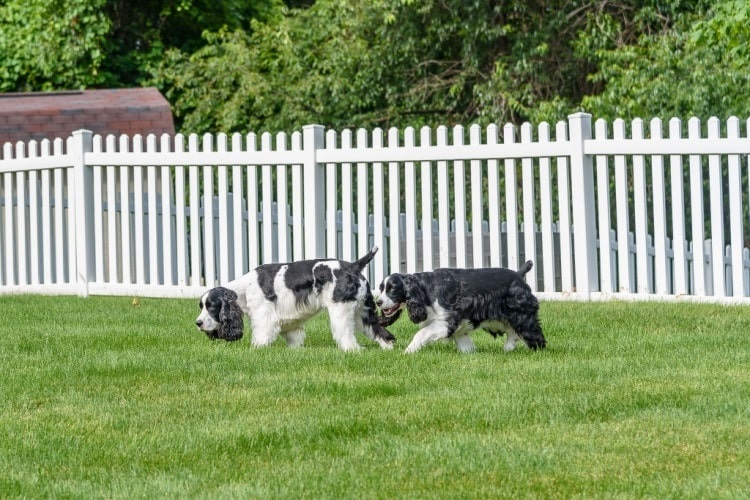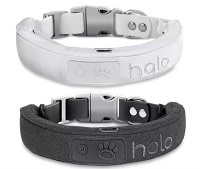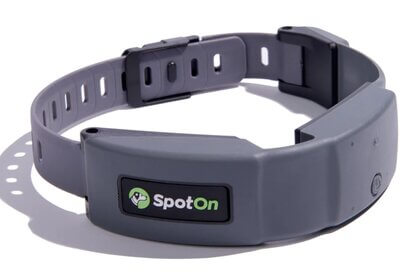Keeping your dog safe means having them under control inside and out, which often means a dog fence. You can take him on frequent walks, and he may love the closeness to you, but the freedom of running in a yard unhindered by a lead or leash will undoubtedly contribute to your dog’s happiness. A dog fence will keep your dog on your property, keep him out of areas such as lower beds where he could cause damage, and prevent him from accessing things that could be dangerous, such as pesticides or other chemicals stored in a shed.
Our vet advisor, Dr. Jamie Whittenburg, DVM, reviewed a variety of dog fences to select the best of the best. She chose the Halo 2 Wireless Dog Fence as the best dog fence for most dogs and their owners. The Halo 2 Wireless Dog Fence is invisible, with no wires required in or above ground, and it allows you to create up to 20 GPS wireless fences anywhere you go, so it’s a convenient portable option, too.
If you’re looking for the best dog fence on the market, look no further than the Halo 2 fence.
While this was Dr. Whittenburg’s top choice, she also offers a series of her top tips for what to look for in choosing the best dog fence, a section on who should avoid purchasing them altogether, and she personally selected the best fence for a variety of specific use cases.
The 5 Best Dog Fences
- Best Overall – Halo 2+ Wireless Dog Fence
- Best Budget – Amazon Basics Foldable Metal Dog Fence
- Best In-Ground – Pet Safe Stubborn Dog In-ground Fence
- Best Portable – FXW Dog Playpen
- Best GPS – Spot on GPS Dog Fence
Dog Fences Compared
Here are the top picks from our veterinarian. Compare the ratings and features of different models.
| Editor’s Picks | Model | Rating | Type | Size/Range | GPS? |
|---|---|---|---|---|---|
| Our Vet’s Top Pick | Halo Dog Fence | n/a | Electric GPS | 20 customizable sizes | |
| Best Budget | _Amazon Basics Foldable Metal Dog Fence_ | Metal Playpen | 60″x60″ | ||
| Best In Ground | _Pet Safe Stubborn Dog In-ground Fence_ | Electric Buried | 500ft | ||
| Best Portable | _FXW Dog Playpen_ | Metal Playpen | 505″ | ||
| Best GPS | SpotOn GPS Dog Fence | Electric GPS | Min of 1/2 acre |
*Ratings are on a scale of 1 to 5 and based on reviews, feedback, and opinions of actual customers
In This Article
Types of Dog Fences: An Overview
One common area of confusion for pet owners is the difference between electric dog fences, wireless dog fences, in-ground dog fences, GPS dog fences, and invisible dog fences. Some people will use these terms slightly differently, but here is a general breakdown:
Electric Dog Fence
An electric fence is any fence that has a correction once crossed. With regards to dogs, this typically refers to a signal sent to a collar, and it usually means a static shock. They can be GPS, in-ground, or wireless fences. It could also just mean a wired fence with an electric current that shocks anything that touches it.
In-ground Dog Fence
An in-ground dog fence will have a wire, which works best buried, that creates a boundary for your dog. It sends a signal to your dog’s collar (included as part of the fence system) that sends a correction if he tries to cross the perimeter
Wireless Dog Fence
Just like an in-ground fence, a wireless dog fence creates a boundary that signals a collar for correction. Unlike the electric fence, though, there are no wires. Instead, there is a base that sends a signal to the collar. As long as your dog is in the range of the hub, then he’s fine. Once he steps out of the base’s range, correction is sent through the collar.
GPS Dog Fences
GPS dog fences will create a boundary that uses GPS coordinates to ensure accuracy. The GPS signal allows you to set several different boundaries, meaning you can create a fence around your home and another around your in-law’s home if you frequently visit them with your pup. They will also signal correction when your dog exceeds the perimeter.
Invisible Dog Fences
Invisible dog fences are fences that create a boundary without being seen. Wireless, in-ground, and GPS dog fences are all examples of this. They will also send a signal to a collar that initiates a correction (the usually static shock).
Who Should Buy a Dog Fence
- Puppy owners – You never know when you get a puppy just how much containment they’ll need. But you know that no matter how much or little he needs, a fence for your fur baby will give him the freedom to stretch his legs unhindered and burn off some of that puppy energy.
- Escape artist owners – When your dog is known for bolting the second you open the door, it may be a good idea to enclose the area so he can’t get too far. A fence in your backyard will likely give your dog fresh air and open space to mitigate some of his impulses to run off.
- Multiple dog families – When you have more than one dog to care for, a good dog fence is an excellent idea. You can’t be everywhere at once, nor can you watch everyone at once, so a dog fence helps to ensure your dogs don’t get into trouble.
Who Should Not Buy a Dog Fence
- Apartment owners – If you don’t have a backyard, then it’s not an excellent idea to invest in a fence. Though you may benefit from a portable fence or gates for traveling, your apartment probably doesn’t present you with the opportunity to use the best fence for dogs.
- Dog parents with landlord or homeowner’s association restrictions – If you rent your home, be sure your landlord permits you to use an in-ground or physical fence before installing one. Likewise, if your home is in a neighborhood subject to homeowner’s association (HOA) rules, you may or may not be allowed to erect a physical fence. On the other hand, your HOA may require you to have a visible fence if your dogs are ever outdoors off-leash. Fortunately, if you’re in one of these situations and need a dog fence, you can probably get away with a portable dog fence in most cases.
Buying Guide: Research Tips from a Veterinarian
Always spend some time researching the features and reliability of each fencing system. Speaking to someone who has used the system you are considering can be invaluable. You may also want to ask your veterinarian or other pet care professional for recommendations. Here are a few other things to consider when searching for a dog fence:
- Remember your circumstances – First, you’ll need to determine your specific needs. How large are your dog(s)? When and where will the fence be used? How much space do you need? Do you need a portable dog fence? You’ll find that while some dogs can be trained to obey the boundaries of an underground, wireless, or invisible fence quite easily while others need a physical fence barrier.
- Traditional fences – Traditional fences will likely give your dog a little more freedom and still protect them from outside predators. You may not worry as much about an electric malfunction, but you will need to frequently check for digging.
- Wireless systems – Wireless systems can be much more cost-effective and visually pleasing than a traditional fence. For dogs that chew or dig under traditional fences, a wireless fence may be a safer and more practical choice. They’re often more affordable compared to installing a physical fence, and many models are portable so you can keep your dog safe anywhere you go.
- Power outages – When you’re choosing a fence, consider the power outages in your area. If you live in a home with frequent outages, then you may want to steer clear of fences that rely on electricity. Power outages or failure to recharge the components can lead to fence failure and put your dog at risk of escape and injury. If you do choose an electric fence, be sure to choose a model that has battery backup so that it won’t fail immediately when an outage occurs.
- Your feelings on shock correction – Though many systems offer alternative corrections, such as vibration or sound, shocking your dog for correction is a method with which all owners may not be comfortable.1
When your pup is outside, there are plenty of things you can do to make his time even more comfortable. Pick a comfortable outdoor bed to make sure he has a comfortable spot out there. Of course, ensure it’s not too cold for him to stay outside.
How Much Do They Cost?
Between $100-$600+
The range for different types of dog fences varies a great deal. Most types of dog fences can be easily purchased online for somewhere from a little over $100 up to $600. When you start talking about the materials and installation costs of traditional fences and privacy fences, however, you could easily spend thousands of dollars to fence your yard. For GPS fences, not only will you be paying for a steep initial cost (sometimes $1,000+), but they will often come with monthly fees, as well. Another thing to consider is that the cost of electric in-ground fences varies based on how large an area you’re covering, as a larger coverage area requires more underground wire.
Our Methodology: Why Trust Pet News Daily
As a veterinarian and pet owner myself, I’ve discussed dog fences with my colleagues and heard plenty of patient horror stories. We’ve determined the best fences for dogs to keep your pup contained and those with the longest durability over years. If you’re still not convinced about the right choice, consult your neighbors and, possibly most importantly, your veterinarian. She likely knows your dog well enough to make recommendations considering your pup’s demeanor. – Dr. Jamie Whittenburg, DVM
The Best Dog Fence Reviews
1. Best Overall – Halo 2+ Wireless Dog Fence
If you’re looking for the best dog fence on the market, look no further than the Halo 2 fence.
The Halo 2+ Wireless Dog Fence utilizes GPS technology to allow you maximum customization for your dog’s designated areas. You can use this fence with or without a Wi-Fi or cellular connection, so you don’t necessarily need to be in a Wi-Fi coverage area to use it.
This collar allows for 20 wireless GPS fences to be created using GPS positioning, so you can create a perimeter for all your most common spots. (And update whenever you stop by a new place!) The ability to create multiple fences easily also means that it’s a great choice if you need a portable dog fence.
- Long-lasting battery life
- GPS enabled
- 3 sizes, 2 colors available
- Requires a monthly fee
- Occasional connection issues
2. Best Budget – Amazon Basics Foldable Metal Dog Fence
The Amazon Basics Foldable Metal Dog Fence is a no-fuss fence solution for your dog that may just be the simplest containment method on our list. There will be no impact from power outages, and your pup is protected from most predators so you won’t need to supervise him the entire time he’s out. (Though you don’t want to leave him in such a small fence for too long.)
This playpen fence is excellent for portability, and you can choose the height of your pen (between 24″ to 48″) making it a solid choice for big or small dogs.
- Portable, folds (nearly) flat
- 60 x 60 playpen
- With or without door
- Less freedom with a smaller space
- No permanent install
3. Best In-Ground – Pet Safe Stubborn Dog In-ground Fence
The Pet Safe Stubborn Dog In-ground Fence is an excellent option for stubborn dogs and for any owner who doesn’t want a traditional fence (or if your HOA doesn’t allow it). You can adjust the fence to whatever shapes and layout you want to ensure your dog has full use of your yard without giving him access to areas that get him into trouble.
It offers multiple correction modes, including beeping, then vibrating when your dog approaches the boundary, and shocking when he crosses it. This correction will allow him to avoid the static shocks altogether after he understands how it works.
- Covers up to 1/3 acre
- Customizable shape
- Waterproof collar
- Occasional connectivity issues
- Not compatible with YardMax receiver collars
4. Best Portable – FXW Dog Playpen
The FXW Dog Playpen collapses and folds easily to allow for travel, and you can choose from several sizing options. From nine different widths to four different heights, there’s every likelihood that you’ll be able to make this fence a convenient portable option for your dog.
This fence’s sturdy construction keeps pets confined safely, preventing them from escaping while also preventing predators from accessing the area. This fact means that you’ll be able to provide a safe enough environment for your pup so that you can take your eyes off him for a bit.
- Durable stake design
- Customizable shapes to accommodate different areas
- Secure locking door
- Not rust-proof
- Small dogs may get stuck between wires
5. Best GPS – Spot on GPS Dog Fence
When you’re looking for a fence that utilizes GPS, don’t miss the SpotOn.
The Spot on GPS Dog Fence uses wireless GPS technology to eliminate unsightly physical fencing and wires. You can create multiple boundaries, making this a portable option that works for the traveling pup. No area is too big, either — you can create a boundary of any size, 1/2 acre and above, and it has 30 levels of correction so you can customize it to the precise amount of correction your dog needs.
There is a 45-day money-back guarantee (no restocking fee!) and a 1-year warranty. You can even manage your dog’s zones directly on your phone. Plus, a subscription is optional.
- Choose from Verizon or AT&T carrier
- 1-year warranty
- 3 collar options
- Requires a monthly fee for tracking and breach alerts
- Needs a minimum of 1/2 acre
Frequently Asked Questions
Additional Sources & Resources
Looking for more information about dog fences? We have a library of in-depth information about various aspects of dog fences. Including tips and ideas for keeping your dog from jumping and building your own dog fence:
- 90+ creative and inexpensive dog fence ideas
- DIY dog fence ideas to build your own dog fence
- How to keep a dog from jumping a fence (or climbing a fence)
- How to keep a dog from digging under a fence
- How tall should a dog fence be?
As well as in-depth reviews of each category of dog fence (with recommendations generated by licensed veterinarians):
- The best dog fences (overall)
- The best in ground dog fences
- The best portable dog fences
- The best GPS dog fences
- The best invisible dog fences
- The best wireless dog fences
- The Best Outdoor Dog Fences
And in-depth product reviews of some of the leading dog fence brands:
- Extreme dog fence review
- Justpet dog fence containment system review
- Halo Collar Wireless Dog Fence Review
Article Sources
Pet News Daily uses only high-quality sources, including peer-reviewed studies, to support the facts within our articles. Read our editorial process to learn more about how we fact-check and keep our content accurate, reliable, and trustworthy.
- Buzhardt L, DVM. VCA Animal Hospitals. The Pros and Cons of Invisible Fences for Dogs. Accessed 28 Aug 2022.
- Logan Wilson S. CanineJournal.com Shock Collar For Dogs: 8 Things To Know Including Pros, Cons & How To Train. Published June 6, 2022. Accessed August 28, 2022.





